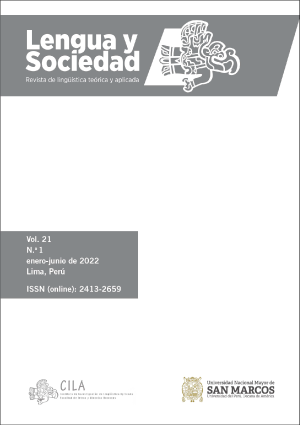Actantial variation in Santiago del Estero Quichua: the applicatives (Part II)
DOI:
https://doi.org/10.15381/lengsoc.v21i1.22617Keywords:
quechua, quichua, applicatives, verbal valency, Santiago del EsteroAbstract
The dialectal variety of Quechua spoken in the province of Santiago del Estero, Argentina, has basically two mechanisms that allow the increase of verbal valency: through causatives or applicatives. In a previous article we have described the mechanisms of increasing verbal valency through applicatives in the case of intransitive verbs. In this paper we return to this issue, extending the analysis for unitransitive and ditransitive verbs by means of examples with verbs of different valency structure. We have also considered cases of combinations between applicatives, their restrictions and the different interpretations that arise according to the context. The results obtained allowed us to determine the limits that verbal valences impose on the behavior of the different types of applicatives.
References
Albarracín de Alderetes, L. I. (2009). La Quichua Volumen I. Gramática, Ejercicios y Diccionario Castellano-Quichua. Dunken.
Albarracín de Alderetes, L. I. (2011). La Quichua Volumen II. Gramática, Ejercicios y Diccionario Quichua-Castellano. Dunken.
Albarracín de Alderetes, L. I. (2016). La Quichua Volumen III. Gramática, Ejercicios y Selección de Textos. Dunken.
Albarracín, L. I. (2017). Diccionario Quichua-Castellano Castellano-Quichua, Variedad de Santiago del Estero. EDUNSE.
Albarracín, L. I. y Alderetes, J. R. (2013). El sufijo -pu en el quichua de Santiago del Estero. En M. Malvestitti y P. Dreidemie (Comps.), III Encuentro de Lenguas Indígenas Americanas/Libro de Actas (pp. 23-33). REUN (Red de Editoriales de Universidades Nacionales).
Albarracín, L. I y Gómez Nazar, R. F. (2021). Variación actancial en quichua santiagueño: los aplicativos (Parte I). Lengua y Sociedad, 20(1), pp. 13-32. https://doi.org/10.15381/lengsoc.v20i1.22266
Albarracín, L.I., Alderetes, J.R. y Tebes, M.C. (Comps.) (2002). Introducción al Quichua Santiagueño por Ricardo Nardi. Dunken.
Calvo Pérez, J. (1993). Pragmática y Gramática del Quechua Cuzqueño. Centro de Estudios Regionales Andinos “Bartolomé de Las Casas”.
Cerrón-Palomino, R. (2003). Lingüística Quechua (2.ª ed.). Centro de Estudios Regionales Andinos “Bartolomé de Las Casas”.
Cuervo, M. C. (2003). Datives at large. MIT Libraries. http://dspace.mit.edu/handle/1721.1/7991
Estomba, D. (2018). “¿Dónde te me lo has ido?”: dilemas de traducción del quechua santiagueño. En Regúnaga M.A., S.A.Spinelli y M.E.Orden (Comps.), IV Encuentro de Lenguas Indígenas Americanas/Libro de Actas (pp.267-285). REUN (Red de Editoriales de Universidades Nacionales).
Itier, C. (1997). Parlons Quechua. La langue du Cuzco. L’Harmattan.
Jiménez, C. C. (2006). Ditransitividad morfológica: tipología y definición de las construcciones aplicativas. ELUA, (20), (pp. 79-104). http://dx.doi.org/10.14198/ELUA2006.20.04
Karlovich, A. (2018). Notas y Estudio Preliminar. En Sosa, J.A. (Ed.). Pallaspa Chinkas Richkaqta, (pp.21-36). Subsecretaría de Cultura de la Provincia de Santiago del Estero.
Kratzer, A. (1996). Severing the External Argument from its Verb. En J. Rooryck and L.Zaring (Eds.), Phrase Structure and the Lexicon (pp. 109-137). Springer.
Marantz, A. (1981). On the nature of grammatical relations. MIT Libraries. https://dspace.mit.edu/handle/1721.1/15848
Martin, J. B. (2000). Creek voice: Beyond valency. En R. M. W. Dixon and A. Y. Aikhenvald (Eds.), Changing Valency (pp. 375-403). Cambridge University Press.
Matera, M. y Medina, R. (2008). La noción de posesión y su relación con el dativo en español. Boletín de Lingüística, 20(30), pp. 106-124. https://www.redalyc.org/articulo.oa?id=34703006
Myler, N. (2016). Building and interpreting possession sentences. MIT Press.
Mithun, M. (2002). Understanding and explaining applicatives. En M. Andronis, C. Ball, H. Elston y S. Neuvel (Eds.), Proceedings of the Thirty-seventh Meeting of the Chicago Linguistic Society: Functionalism and formalism in Linguistic Theory, 37(2), pp.73-98.
Payne, T. E. (1997). Describing Morphosyntax. A Guide for Field Linguists. Cambridge University Press.
Peterson, D.A. (2007). Applicative Constructions. Oxford University Press.
Polinsky, M. (2005). Applicative Constructions. En M. Haspelmath, M. S. Dryer, D. Gil y B. Comrie (Eds.), The World Atlas of Language Structures (pp. 442-445). Oxford University Press.
Pylkkänen, L. (2008). Introducing Arguments. MIT Press.
Queixalós, F. y García Rivera, F. (2003). Efectos morfológicos de la pragmática en el verbo quechua. En G. Solís Fonseca (Ed.), Cuestiones de Lingüística Amerindia. Tercer Congreso Nacional de Investigaciones Lingüísticas-Filológicas (pp. 105-119). PROEIB-Andes, GTZ, UNMSM y UNA.
Tebes, M. C. (2009). Castañumanta Yuyayniy. Ni los años ni la distancia. Dunken.
Tebes, M. C. y Karlovich, A. (Comps.) (2006). Sisa Pallana. Antología de textos quichuas santiagueños. Eudeba.
Tesnière, L. (1969 [1994]). Elementos de sintaxis estructural. Madrid: Gredos.
Sosa, J. A. (2018). Pallaspa Chinkas Richkaqta. Subsecretaría de Cultura de la Provincia de Santiago del Estero.
Downloads
Published
Issue
Section
License
Copyright (c) 2022 Lelia Inés Albarracín, Regina Fernanda Gómez Nazar

This work is licensed under a Creative Commons Attribution 4.0 International License.
AUTHORS RETAIN THEIR RIGHTS
a. Authors retain their trade mark rights and patent, and also on any process or procedure described in the article.
b. Authors can submit to the journal Lengua y Sociedad, papers disseminated as pre-print in repositories. This should be made known in the cover letter.
c. Authors retain their right to share, copy, distribute, perform and publicly communicate their article (eg, to place their article in an institutional repository or publish it in a book), with an acknowledgment of its initial publication in the journal Lengua y Sociedad.
d. Authors retain theirs right to make a subsequent publication of their work, to use the article or any part thereof (eg a compilation of his papers, lecture notes, thesis, or a book), always indicating its initial publication in the journal Lengua y Sociedad (the originator of the work, journal, volume, number and date).






